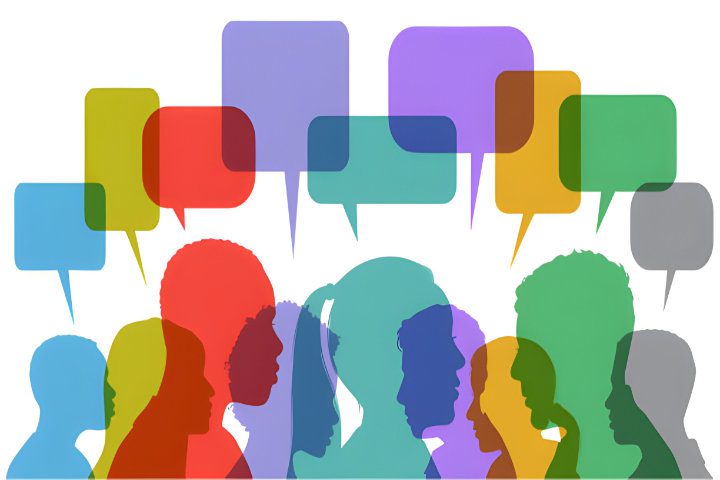UGC NET Previous Year Question Paper Question: In the mediated world, a temporary and incomplete consensus is called: A. Publicity B. Public opinion C. Public relations D. Propaganda This question falls under Section 10: Models and Theories of Mass Communication in Unit 1: Introduction to Journalism and Mass Communication. Specifically, it relates to concepts of public opinion and communication effects in a mediated world. The question deals with the nature of consensus in a media-influenced environment, which is a fundamental concept in understanding how mass communication affects public opinion and social dynamics. This topic is crucial for studying communication theories and their societal impacts. Answer: B. Public opinion
What is Public Opinion?
Public opinion refers to the collective views, attitudes, and beliefs that shape society’s perspective on various issues. In India’s dynamic democracy, public opinion is a crucial bridge between citizens and their elected representatives. It is particularly relevant in mass communication because media content frequently shapes and reflects it.
In This Article
Characteristics of Public Opinion

There are two important characteristics of public opinion:
- Transient (temporary) in Nature: Public opinion is subject to change due to new information, events, or media coverage.
- Lack of Consensus: In a dynamic democracy such as Indian society, with a wide range of perspectives and multiple media outlets, complete agreement on any issue is rare. Public opinion generally represents the collective views of the majority or a significant portion of people rather than absolute agreement among everyone.
The media ecosystem in India significantly impacts shaping public opinion, with various platforms like traditional newspapers, 24×7 news channels, WhatsApp forwards, and viral tweets playing a crucial role.
Media outlets serve as mirrors, faithfully reflecting the opinions and concerns of the public. However, the media also has the power to shape public opinion. The manner in which news is presented, the topics that are given importance, and even the choice of words can greatly impact how individuals perceive events and shape their opinions.

For example, the media’s coverage of the COVID-19 pandemic in India had a significant impact on how the public perceived safety measures, vaccine effectiveness, and government actions. The continuous flow of information (and at times, misinformation) had a noticeable effect on public behavior and the acceptance of policies.
Distinction from Other Options
Publicity
Publicity refers to the public attention given to something through the media. This tool can shape public opinion, but it is important to note that it is not the opinion itself.
Public Relations
Public relations is the strategic communication process that builds mutually beneficial relationships between organizations and their publics. It aims to influence public opinion but is not the opinion itself.
Propaganda
Propaganda is information, especially of a biased or misleading nature, used to promote a particular political cause or point of view. This method aims to shape public opinion rather than directly influence it.
Media Affecting Public Opinion
Agenda Setting
The media has the power to shape public opinion by directing people’s attention to specific topics. Some issues receive significant media attention, while others are largely overlooked. This exemplifies agenda-setting in action.
Here’s how it works:
- The media outlets convey the significance of various issues by selectively covering them in depth.
- By giving more airtime or column space to certain topics, they elevate these issues in the public consciousness.

Let us take Delhi’s air pollution coverage as an example. Media outlets significantly raise awareness about air pollution by consistently reporting on the air quality index, showing images of smog-filled streets, and interviewing health experts.
People begin to engage in more discussions, even if they are not personally impacted. As a result, air pollution has become a widely discussed issue in public debates, potentially impacting policy decisions and individual actions.
Framing
The concept of agenda setting focuses on shaping our thoughts, while framing influences how we perceive and approach those thoughts. The media has a powerful impact on our perception and understanding of issues.
Here’s how it works:
- Media outlets often present issues within a specific context or ‘frame.’
- This frame can highlight specific aspects of an issue while minimizing others.
Take, for example, the extensive reporting on the farmer protests in India. Various media outlets presented the issue from different perspectives:
- Some framed it as a fight for farmers’ rights and livelihood.
- Others framed it as an obstacle to economic reform.
- Some focused on the inconvenience caused to city dwellers due to the protests.
Each frame leads the audience to think about the issue from a particular perspective, potentially influencing their opinion.
Cultivation Theory
This theory explores the impact of media exposure on our worldview over time. Extended exposure to media can gradually influence our perception of the world, sometimes leading to a distorted understanding of reality.
Here’s how it works:
- Regular exposure to specific media messages can influence how we perceive reality.
- It is especially impactful for viewers with limited first-hand experience with a topic.
Let us examine how crime is depicted in Indian television news and crime shows. If someone watches a lot of crime-related content, they might start to believe that crime rates are much higher than they are, leading to increased fear and anxiety about personal safety.
This perception can impact their behavior, such as avoiding specific areas and installing security systems. It may also shape their political views, leading to support for stricter law enforcement policies.
Public Opinion and Democracy: Theoretical Background
Jürgen Habermas’s Concept of the Public Sphere
Jürgen Habermas, a German philosopher and sociologist, discussed the concept of the public sphere in his work “The Structural Transformation of the Public Sphere.” The public sphere is a space in society where individuals can freely discuss and deliberate on matters of common interest without any governmental or economic control.
The space is essential for a democratic society to function properly. It enables the formation of public opinion, which has the power to impact political decision-making.
The public sphere in a democratic context, the public sphere acts as a platform for citizens to participate in discussions, share ideas, and provide feedback on societal matters. It provides a forum for critical thinking and deliberation where facts and logic, rather than propaganda or skewed information, shape opinions.
Habermas argues that the public sphere should be inclusive for a healthy democracy, allowing all members of society to participate equally. This inclusivity ensures that diverse perspectives are considered in forming public opinion, leading to more representative and legitimate democratic decisions.
Walter Lippmann’s Work on Public Opinion
Walter Lippmann, an American journalist and political commentator, explored the nature of public opinion in his book “Public Opinion.” He claimed that various factors, including the media, shape public opinion rather than being a direct reflection of reality.
According to Lippmann, the world is too complex for individuals to fully understand, so they rely on simplified images and stereotypes—what he called “pictures in our heads”—to make sense of it.
Lippmann’s insights emphasize the important role of the media in shaping public opinion within a democratic context. The media plays a crucial role in connecting world events with how the public perceives them. Through their careful selection, framing, and presentation of information, they can shape public perception and response to societal issues.
Lippmann expressed concern about the potential consequences of this process for public opinion and its impact on democratic processes. He emphasized the importance of people being well-informed and not being misled by biased or inaccurate information.
Habermas and Lippmann both emphasize the significance of an informed and engaged public for democracy to function effectively. Habermas highlights the importance of a public sphere that allows for rational debate, while Lippmann addresses the difficulties associated with shaping public opinion through the media.
These perspectives indicate that a thriving democracy requires mechanisms to facilitate the free flow of information, encourage critical engagement, and safeguard against misinformation and manipulation.
In a democratic society, public opinion plays a crucial role in connecting the people with the government. It provides feedback to leaders, guides policymaking, and holds officials accountable. However, the quality of public opinion depends on the accessibility and integrity of information and the inclusivity of public discourse.
To maintain a thriving democracy that accurately represents the public’s desires and necessities, it is essential to prioritize safeguarding the public sphere and promoting media literacy.
Social Media and Public Opinion
The emergence of social media and digital platforms has completely transformed the public opinion landscape in India. India’s digital space is a thriving hub of opinion formation and expression, with over 700 million internet users.
Platforms such as Twitter, Facebook, and WhatsApp have provided a platform for millions with limited opportunities to engage in public discussions. A tweet from a remote village has the potential to reach the highest levels of government.
However, the digital revolution comes with its own set of challenges. The phenomenon of echo chambers, where individuals are exposed only to opinions that align with their own, is a growing concern.

Moreover, spreading fake news and misinformation through digital channels can distort public opinion, sometimes with serious consequences. For instance, there have been cases of mob lynchings triggered by WhatsApp rumors. These tragic events highlight the dark side of unverified information shaping public opinion in the digital age.
Public Opinion and Policy Making
Public opinion influences the policies that lawmakers create, and in turn, these policies shape future public opinion.
Let’s consider the case of the Swachh Bharat Abhiyan (Clean India Mission). The campaign was launched in response to a growing public concern about sanitation and cleanliness. As the campaign progressed, it not only led to infrastructural changes but also influenced public opinion about cleanliness and civic responsibility. This shift in opinion then reinforced support for further cleanliness initiatives, creating a positive feedback loop.
It is worth mentioning that the connection between public opinion and policy can be quite complex. Sometimes, governments may need to make decisions that are not always popular but are necessary for long-term benefits. The economic reforms of 1991 in India, for example, initially faced public skepticism but are now widely recognized for bringing about a new era of economic growth.
Public Opinion and Survey Research
Gauging public opinion in India, with its diverse languages, cultures, and socio-economic realities, is a challenging task. Although helpful, conventional methods such as opinion polls and surveys often find it difficult to grasp the intricate nature of Indian public opinion fully.
For example, a poll conducted mainly in urban areas may overlook important perspectives from rural India. Surveys that are conducted solely in Hindi or English would not capture the perspectives of a significant portion of the population that primarily communicates in other languages.

According to media reports, the opinion polls and seat predictions of elections in India have had varying degrees of success and failure. The outcome of the 2024 general election in India demonstrates this.
New techniques are emerging to tackle these challenges. Advanced tools such as big data analysis, sentiment analysis, and AI-powered natural language processing are helping to gain a more comprehensive understanding of public opinion in India.
Public Opinion and Social Change
Public opinion has played a significant role in driving social change throughout India’s history. Changes in public opinion have frequently paved the way for significant societal transformations, spanning from the independence movement to more recent social reforms.
For instance, consider the changing attitudes towards gender roles and women’s rights. Attitudes toward women’s education, workplace participation, and leadership roles have changed greatly over time. This shift in opinion has been instrumental in bringing about legal and social changes, such as the implementation of laws against domestic violence and the increased representation of women in politics and corporate leadership.
On 21 September, 2023, the Indian Parliament passed the Women’s Reservation Bill, 2023. This bill aims to increase female representation by mandating that women occupy at least 33 percent of seats in state legislative assemblies and the Lok Sabha, the lower house of Parliament.
Public Opinion and International Diplomacy
It’s crucial to understand that different factors influence Indian public opinion, which does not form in a vacuum in our interconnected world. Global events and international relations greatly shape Indian public opinion, which in turn has a significant impact on it.
For example, the recent farmer protests in India received significant global attention, with public sentiment from both within and outside India influencing the course of events.

Similarly, public opinion within India significantly impacts its stance regarding international matters such as climate change and conflicts like the Ukraine War. Moreover, it also plays a crucial role in shaping global perspectives, as evident from this report by the Carnegie Endowment for International Peace.
Anticipating the Influence of Public Opinion on Indian Democracy
In considering the future, it is important to acknowledge several trends that are expected to influence public opinion in India significantly:
- Increased Digital Penetration: With the growing number of Indians accessing the internet, digital platforms are set to have a greater impact on shaping opinions and facilitating expression.
- AI and Big Data: Advanced technologies like AI and Big Data will provide new avenues for analyzing and understanding public opinion, which could result in more responsive governance.
- Personalized Information Ecosystems: Personalized Information Ecosystems: The issue of echo chambers and filter bubbles may become more pronounced, necessitating creative solutions to promote exposure to a wide range of perspectives.
- Global Interconnectedness: Indian public opinion is set to have a growing impact on global discussions regarding climate change, economic policies, and human rights.
- Evolving Media Landscape: The media landscape in India is constantly evolving, leading to changes in how news and information are consumed. This, in turn, can impact the formation and expression of public opinion.
Conclusion
Public opinion in India is of immense significance, as it serves as the lifeblood of our democracy. It’s the force that can topple governments, spark revolutions, and drive societal progress. It highlights the dynamic and sometimes disjointed nature of collective perspectives in contemporary society, greatly influenced by mass media, personal interactions, and individual encounters.





